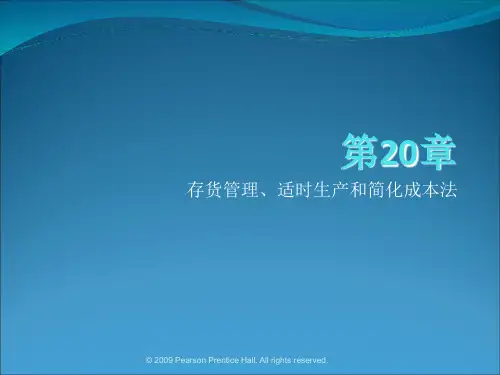成本与管理会计 亨格瑞 第13版 英文版 CA02
- 格式:ppt
- 大小:1.46 MB
- 文档页数:70
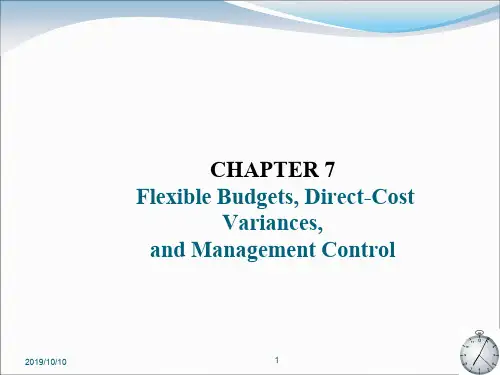

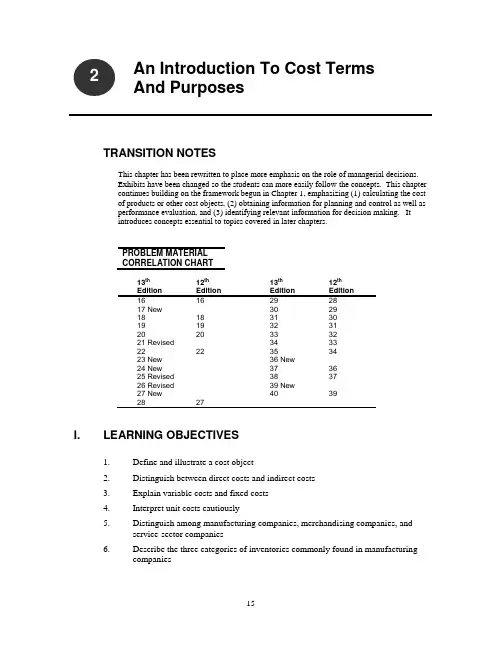
An Introduction To Cost TermsAnd PurposesTRANSITION NOTESThis chapter has been rewritten to place more emphasis on the role of managerial decisions.Exhibits have been changed so the students can more easily follow the concepts. This chapter continues building on the framework begun in Chapter 1, emphasizing (1) calculating the cost of products or other cost objects, (2) obtaining information for planning and control as well as performance evaluation, and (3) identifying relevant information for decision making. It introduces concepts essential to topics covered in later chapters.PROBLEM MATERIALCORRELATION CHART13th Edition 12thEdition13thEdition12thEdition16 16 29 2817 New 30 2918 18 31 3019 19 32 3120 20 33 3221 Revised 34 3322 22 35 3423 New 36 New24 New 37 3625 Revised 38 3726 Revised 39 New27 New 40 3928 27I. LEARNING OBJECTIVES1.Define and illustrate a cost object2.Distinguish between direct costs and indirect costs3.Explain variable costs and fixed costs4.Interpret unit costs cautiously5.Distinguish among manufacturing companies, merchandising companies, andservice-sector companies6.Describe the three categories of inventories commonly found in manufacturingcompanies27.Distinguish inventoriable costs from period costs8.Explain why product costs are computed in different ways for different purposes9.Describe a framework for cost accounting and cost managementII. CHAPTER SYNOPSISChapter 2 defines and explains important cost accounting terms and concepts that will be discussed in the following chapters. Understanding the concepts and terms discussed inthis chapter is a prerequisite to successfully completing the remaining chapters of the text.One guiding principle is that the term cost is a relative term, dependent both on the “costobject” chosen and the purpose for which cost is being calculated and reported.Costs are a critical element in most business decisions. Students also need to recognizethat companies pay particular attention to costs because every dollar in cost reduction isone more dollar of operating income, whereas one more dollar of sales does notnecessarily result in the same impact due to the additional costs that may be incurred ingenerating those sales.“Cost” is often actually “estimated cost” due to difficulties involved in cost tracing andallocation, relevant range issues, which cost method is used, and the cost-benefitapproach to measuring costs. Although there are certain standard costing and reportingmethods followed by all, companies calculate and report the same types of datadifferently depending on their industry and sector. Companies commonly operate in themerchandising, manufacturing, and service sectors.III. POINTS OF EMPHASIS1.Although terminology can be boring, it is important that the students grasp andunderstand the terms introduced in this chapter. They will have some familiaritywith some of the terms; however, remind them that these words may havemeanings that are different in a cost accounting context.2.The distinction between inventoriable (or product) cost and period cost is animportant one that students may have some trouble grasping, as they areaccustomed to treating items such as wages, rent, utilities, and the like asexpenses of the period. Likewise, the term conversion cost is one that should bemastered early on.IV. CHAPTER OUTLINETEACHING POINT. The terminology in this chapter is importantfor the student to gain an understanding early in the course. Incovering the chapter, it is very beneficial to repeatedly askquestions such as: (1) What is the cost object in the situation? (2)What costs can be traced? and (3) Which costs are allocated?1Define and illustrate a cost object. . . examples of cost objects are products,services, activities, processes, and customers1.1Cost is a resource sacrificed or forgone to achieve a specific objective.1.2Actual cost is the historical amount, or cost incurred, as distinguished frombudgeted cost, which is the planned (or future) amount of cost.1.3Cost object is the purpose for which costs are being measured. Stated anotherway, the cost object is anything for which a measurement of costs is desired. For example, this can be a product, an assembly line, a product line, or a department.TEACHING POINT. Discuss with the students the concept ofcost object. Use different examples of cost objects. Help themrelate the concept to their own lives. The cost of taking a tripduring spring break, the cost of a date, the cost of a collegeeducation, and the cost of a single class—all make goodtalking points.(Exhibit 2-1 illustrates examples of cost objects at BMW.)1.4Cost Accumulation describes the process of accumulating costs in someorganized manner through the accounting system. Following accumulation, costs are assigned to the chosen cost object.1.5The process of cost assignment involves tracing and allocating costs,depending on the type of cost involved.Refer to Quiz Question 12Distinguish between direct costs and indirect costs. . . costs that are traced directly to the cost objectand indirect costs. . . costs that are allocated to the cost object2.1 Direct costs of a cost object are costs that are related to the cost object and canbe traced to it in an economically feasible manner. Many costs may be able to betraced to the cost object, but it is not always practical to do so from a cost-benefitperspective.2.2 Direct cost categories include direct materials and direct manufacturing labor.Direct materials are materials that go into the production of the product. Directlabor is the wages paid to workers who spend time working on the product.2.3 Indirect costs of a cost object are related to the cost object but cannot be tracedin an economically feasible manner. These costs are frequently referred to asfactory overhead, manufacturing overhead, or some similar term. These costsinclude supervisor salaries, supplies, or other costs incurred in the factory that arenot direct materials or direct labor.TEACHING POINT. Make the observation that the same costmay be direct or indirect depending on the cost object. Usesome illustrations. For example, a line supervisor in a factorycould be a direct cost if the cost object were the particularassembly line, but would be indirect if the finished product isthe cost object.2.4 There are several factors that affect the classification of costs as direct or indirect.Three of these factors include:•Materiality of the cost. The smaller the amount of the cost, the lesslikely that it is economically feasible to trace that cost to a particular costobject.•Ease of gathering the information. For example bar-code technologyhas made it possible to trace just about any material used in themanufacturing process.•Design of operations. A cost used exclusively for a specific cost objectcan be readily traced.(Exhibit 2-2 illustrates the assignment of direct and indirectcosts at BMW.)TEACHING POINT. Use an object in the classroom, such as astool or chair. Place it on a desk or somewhere the students caneasily see it. Ask: “W hat are the materials used in manufacturingthe object?” Once a list of materials is compiled, then have thestudents determine which are direct material costs and whichare indirect costs.Refer to Quiz Question 2 Exercise 2-17only ID as Direct or IndirectExplain variable costs and fixed costs. . . the two basic ways in which costs behave3.1 In order to adequately predict costs, their behavior must be understood. From abehavioral view, costs are classified as fixed or variable.3.2 A variable cost changes in proportion with changes in the activity level. Forexample, if the number of units produced doubles, direct materials (a variablecost) would double in total. Note, however, that the variable cost per unit staysthe same.3.3 Fixed costs do not change due to changes in the activity level. If units produceddoubles, fixed costs remain the same in total. However, when expressed on a per-unit basis, fixed costs would decline with an increase in activity.(Exhibit 2-3 displays the cost behavior of variable and fixedcosts in total.)3.4 Costs are not inherently fixed or variable; it depends on the defined cost object.They may be variable with respect to level of activity and fixed for another.3.5 A cost driver is what causes a cost to be incurred. Stated another way there is acause-and-effect relationship between the level of activity of the cost driver andthe cost incurred.TEACHING POINT. Use several examples that will help thestudents grasp this concept. For example, their cost ofgasoline is determined largely by the number of miles driven.This can also be used to illustrate that most costs, in realityhave multiple drivers. Gas cost is also affected by type ofdriving, the horsepower of the engine, and other factors.3.6 Relevant range is the range of activity within which costs behave as predicted.Outside this level of activity, costs behave differently. This is not a concept thatcan be determined from a textbook; observation of the actual costs must be donein order to determine this range.(Exhibit 2-4 illustrates the relevant range of fixed costs atThomas Transport Company.)3.7 In dealing with costs, it is important to distinguish between behaviors of costswhen expressed as unit costs and when dealing with total costs. Generally,decision makers should think in terms of total cost. However, in many decisionanalysis situations, calculating unit costs is essential.Refer to Quiz Question 3 Exercises 2-17 (fixed and variable) and 2-23Interpret unit costs cautiously. . . for many decisions, managers should use totalcosts, not unit costs4.1 Unit costs (also called average costs) are normally used in making decisions suchas product mix and pricing. However, managers should usually think in terms oftotal costs for most decisions.4.2 Fixed costs, when expressed on a unit basis can be misleading. For example, iffixed costs are $25,000 and you manufacture 5.000 units, fixed costs are $5 perunit. When production increases to 6,250 units, total fixed costs remain at$25,000, but the unit cost declines to $4. Avoid using the higher unit cost whenproduction level changes.Refer to Quiz Question 4 Exercise 2-275Distinguish among manufacturing companies,merchandising companies, and service-sectorcompanies. . . different types of companies face differentaccounting issues5.1 Manufacturing-sector companies purchase materials and components andconvert them into finished products.5.2 Merchandising-sector companies purchase and sell tangible products withoutchanging their basis form. These companies are known as retailers.5.3 Service-sector companies provide services (intangibles). However, there isfrequently a tangible aspect to the service.TEACHING POINT. Have the students name companies thatare representative of each sector. Likely, they will correctlyidentify the proper sector for each company. Point out,however, that a service company may have a tangible aspect,such as the tax return as the end product of a tax preparationservice. Conversely, a merchandising company mayemphasize the intangibles. As the saying goes, “sell the sizzle,not the steak.”Refer to Quiz Question 56Describe the three categories of inventoriescommonly found in manufacturing companies. . . the categories are direct materials, work inprocess, and finished goods6.1 The accounting system of a manufacturing company is more complex than for amerchandising or service company. The main reason for this complexity is in theinventories held by a manufacturer. These companies will have three types ofinventory.•Direct Materials Inventory, or simply Materials Inventory, consists of materials being held by the company, ready to begin the conversionprocess into a finished product.•Work-in-Process Inventory represents product partially worked on but not yet completed. WIP is a representation of what is on the factory floor.•Finished Goods Inventory is product that has been completed and has not yet been sold.6.2 Merchandising companies purchase products in their completed form and do notmake changes in their basic form. An inventory account for a merchandisingcompany is called Merchandise Inventory, or simply Inventory.6.3 The Work-in-Process account will have three debits, representing the three typesof manufacturing costs.•Direct material costs are the costs of materials that become part of the cost object and can be traced to the cost object in an economicallyfeasible manner.•Direct manufacturing labor costs include compensation ofmanufacturing labor that can be traced to the cost object in aneconomically feasible manner. This includes labor of workers who workdirectly on the product.•Indirect manufacturing costs are all manufacturing costs that are not direct materials or direct labor. These costs are allocated rather thantraced. Other terms for this category include manufacturing overhead orfactory overhead costs.Refer to Quiz Question 67Differentiate inventoriable costs. . . assets when incurred, then cost of goods soldfrom period costs. . . expenses of the period when incurred7.1 Inventoriable costs are all costs of a product that are considered assets on thebalance sheet. These costs are direct materials, direct labor, and factory overhead.They become a part of the cost of the product and are assets until sold, when they become cost of goods sold. These are also known as product costs.7.2 Period costs are all costs on the income statement other than cost of goods sold.Period costs are treated as expenses of the period in which they are incurred.7.3 Prime cost is a term used to describe all direct costs or direct materials plusdirect labor.7.4 Conversion cost is direct materials plus factory overhead. It is the cost ofconverting the materials into a finished product.TEACHING POINT. Many companies with highly automatedmanufacturing operations have little or no direct labor. Thesecompanies often only use two categories of manufacturingcosts—direct materials and conversion cost.7.5 Costs can be measured in different ways. The management accountant shoulddefine and understand the ways costs are measured in a particular company orsituation.TEACHING POINT. Labor costs can include only the wagepaid to the workers or it can be broadened to include the costof that labor to the employer—the wage rate plus the cost ofbenefits the employee receives. Overtime premium can betreated as direct labor or as overhead.(Exhibit 2-6 illustrates examples of period costs in a bank.)(Exhibit 2-7 shows the flow of costs through the three differenttypes of manufacturing inventory.)(Exhibit 2-8 uses a sample Cost of Goods Manufacturedschedule and a sample Income Statement to illustrate thecalculation and reporting of Cost of Goods Sold.)7.6 Two issues in cost measurement that require special attention are idle time andovertime premium. Idle time is wage paid for unproductive time caused by lackof orders, machine breakdowns, or other reasons. Overtime premium is the wagerate paid to workers in excess of their regular straight-time wage rate. Both ofthese are considered as overhead rather than direct labor costs.Refer to Quiz Questions 7 and 8 Assign Exercises 2-26 and 2-288Explain why product costs are computed indifferent ways for different purposes. . . examples are pricing and product-mixdecisions, government contracts, and financialstatements8.1 Product cost is a term with an ambiguous meaning because there are differentdefinitions of product cost depending on the purpose for measuring that cost.8.2 Pricing and product decisions require an emphasis on the total profitability ofdifferent products and would assign costs incurred in all business functions to theproduct.8.3 Contracting with government agenc ies is frequently done on the “product cost”plus a specified mark up. This is known as cost plus pricing. Governmentagencies frequently have detailed specifications about what costs can be includedin the cost base.8.4 Reporting product cost for financial statement purposes requires adherence toGAAP guidelines for costing.(Exhibit 2-11 illustrates how product costs can vary dependingon the purpose for which product cost is being calculated.)(Exhibit 2-12 lists alternative classifications of costs.)Refer to Quiz Question 99Describe a framework for cost accounting and costmanagement. . . three features that help managers makedecisions9.1 This chapter deals with a number of cost terms and purposes. These concepts canbe expressed in three features of cost accounting that have a wide range of usesin business applications.•Calculating the cost of products, services, and other cost objects.Managers use this information in a variety of ways to formulate strategyand make various decisions.•Obtaining information for planning and control and forperformance evaluation. Budgeting is the most commonly used tool forplanning and control and forces managers to:o Look aheado Translate strategy into planso Coordinate and communicate within the organizationo Provide a benchmark for evaluating performance•Analyzing the relevant information for making decisions. Managers must understand which revenues to consider and which to ignore in thedecision-making process. Management accounting can assist managers indetermining which costs are relevant.Refer to Quiz Question 10V. OTHER RESOURCESPlease visit the textbook companion website at . To download these and other resources, visit the Instructor’s Resource Center or access them on the Instructor’s Resource DVD (IR-DVD).The following exhibits were mentioned in this chapter of the Instructor’s Manual, and havebeen included in the PowerPoint Lecture presentation created specifically for this chapter.You may use the PowerPoint Lecture presentations “as is”, or modify them to suit yourindividual needs.Exhibit 2-1 illustrates examples of cost objects at BMW.Exhibit 2-2 illustrates the assignment of direct and indirect costs at BMW.Exhibit 2-3 displays the cost behavior of variable and fixed costs in total.Exhibit 2-4 illustrates the relevant range of fixed costs at Thomas Transport CompanyExhibit 2-6 illustrates examples of period costs in a bank.Exhibit 2-7 shows the flow of costs through the three different types of manufacturinginventory.Exhibit 2-8 uses a sample Cost of Goods Manufactured schedule and a sample IncomeStatement to illustrate the calculation and reporting of Cost of Goods Sold.Exhibit 2-11 illustrates how product costs can vary depending on the purpose for whichproduct cost is being calculated.Exhibit 2-12 lists alternative classifications of costs.Download pdf images of textbook illustrations and exhibits from the Image Library oraccess them via your IR-DVD.Solutions to Select End-of-Chapter Problems mentioned in this chapter, which have been fully worked out in PowerPoint, are available for download and included on the IR-DVD.CHAPTER 2 QUIZ1.Tanner Co. management desires cost information regarding their Rawhide brand. TheRawhide brand is a(n)a.cost object.b.cost driver.c.cost assignment.d.actual cost.2.The cost of replacement light bulbs on campus would be a direct cost to a college butwould need to be allocated as an indirect cost toa.departments.b.buildings.c.schools.d.individual student instruction.3.What is the total fixed cost of the shipping department of EZ-Mail Clothing Co. if it hasthe following information for 2002?Salaries $800,000 75% of employees on guaranteed contractsPackaging $400,000 depending on size of item(s) shippedPostage $500,000 depending on weight of item(s) shippedRent of warehouse space $250,000 annual leasea. $850,000b. $900,000c. $1,050,000d. $1,950,0004.Morton Graphics successfully bid on a job printing standard notebook covers during theyear using last year’s price of $0.27 per cover. This amount was calculated from prioryear costs, noting that no changes in any costs had occurred from the past year to thecurrent year. At the end of the year, the company manager was shocked to discover that the company had suffered a loss. “How could this be?” she exclaimed. “We had noincreases in cost and our price was the same as last year. Last year we had a healthyincome.” What could explain the company’s loss in income this current year?a.Their costs were all variable costs and the amount produced and sold increased.b.Their costs were mostly fixed costs and the amount produced this year was lessthan last year.c.They used a different cost object this year than the previous year.d.Their costs last year were actual costs but they used budgeted costs to make theirbids.5.Which type of company converts materials into finished products?a.Not-for-profitb.Servicec.Merchandisingd.Manufacturing6.The three categories of inventories commonly found in many manufacturing companiesare:a.Direct materials, direct labor, and indirect manufacturing costs.b.Purchased goods, period costs, and cost of goods sold.c.Direct materials, work in process, and finished goods.d.LIFO, FIFO, and weighted average.7.Inventoriable costs area.only purchased goods for resale.b. a category of costs used only for manufacturing companies.c.recorded as expenses when incurred and later reclassified as assets.d.recorded as assets when incurred.8.Period costs area.all costs in the income statement other than cost of goods sold.b.defined as manufacturing costs incurred this period on the schedule of cost ofgoods manufactured.c.always recorded as assets when first incurred.d.those costs that benefit future periods.9.The cost of a product can be measured as any of the following except as costa.gathered from all areas of the value chain.b.identified as period cost.c.designated as manufacturing cost only.d.explicitly defined by contract.10.The primary focus of cost management is toa.help managers make different decisions.b.calculate product costs.c.aid managers in budgeting.d.distinguish between relevant and irrelevant information.CHAPTER 2 QUIZ SOLUTIONS1. a2. d3. a4. b5. c6. c7. d8. a9. b10. aQuiz Question Calculations3. Fixed costs = (800,000) 75% + 250,000 = $850,000。
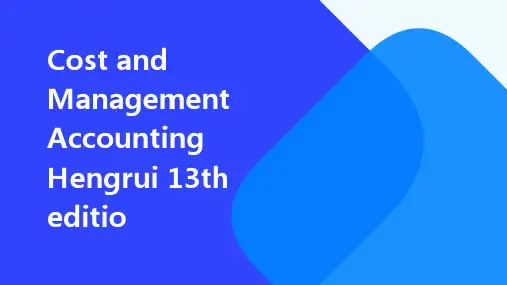


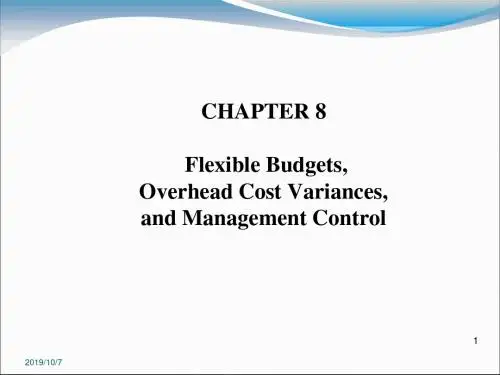
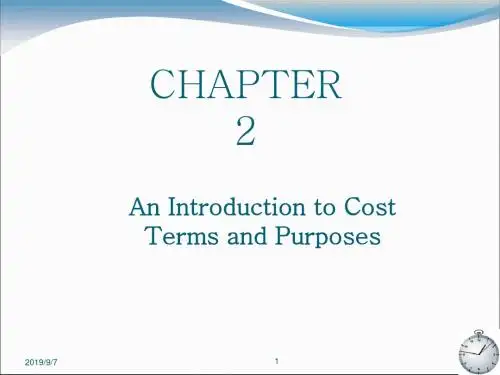
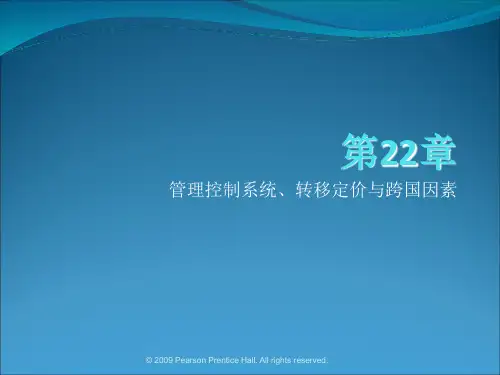
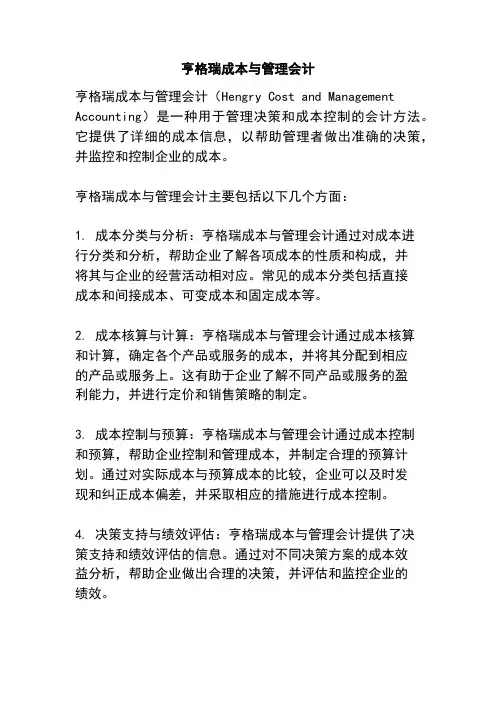
亨格瑞成本与管理会计
亨格瑞成本与管理会计(Hengry Cost and Management Accounting)是一种用于管理决策和成本控制的会计方法。
它提供了详细的成本信息,以帮助管理者做出准确的决策,并监控和控制企业的成本。
亨格瑞成本与管理会计主要包括以下几个方面:
1. 成本分类与分析:亨格瑞成本与管理会计通过对成本进
行分类和分析,帮助企业了解各项成本的性质和构成,并
将其与企业的经营活动相对应。
常见的成本分类包括直接
成本和间接成本、可变成本和固定成本等。
2. 成本核算与计算:亨格瑞成本与管理会计通过成本核算
和计算,确定各个产品或服务的成本,并将其分配到相应
的产品或服务上。
这有助于企业了解不同产品或服务的盈
利能力,并进行定价和销售策略的制定。
3. 成本控制与预算:亨格瑞成本与管理会计通过成本控制
和预算,帮助企业控制和管理成本,并制定合理的预算计划。
通过对实际成本与预算成本的比较,企业可以及时发
现和纠正成本偏差,并采取相应的措施进行成本控制。
4. 决策支持与绩效评估:亨格瑞成本与管理会计提供了决
策支持和绩效评估的信息。
通过对不同决策方案的成本效
益分析,帮助企业做出合理的决策,并评估和监控企业的
绩效。
总之,亨格瑞成本与管理会计是一种重要的管理工具,通过提供详细的成本信息和决策支持,帮助企业进行成本控制和管理,并提高企业的绩效和竞争力。
